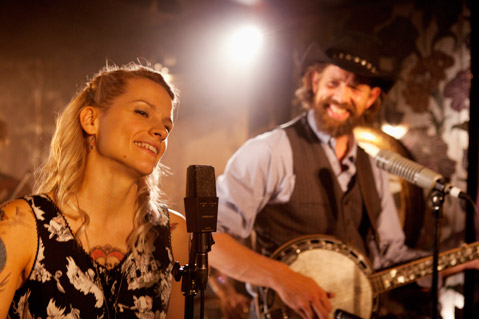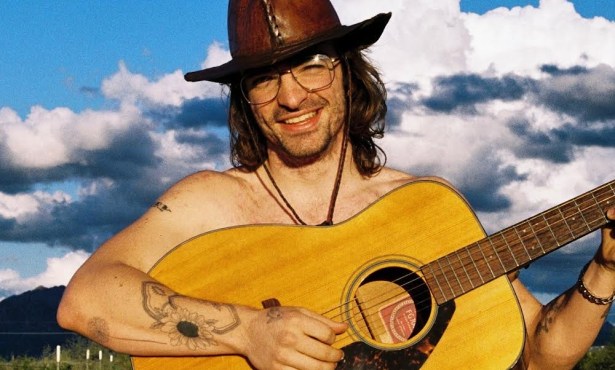The Broken Circle Breakdown
Director Felix Van Groeningen

If you like your love stories served with a harsh dose of reality, look no further than Felix Van Groeningen’s The Broken Circle Breakdown. The Dutch romantic drama (and Academy Award nominee for Best Foreign Picture) is based on a play of the same name, which was written by the film’s star, Johan Heldenbergh.
Heldenbergh plays Didier, a rugged and puppy dog-eyed banjo player who falls hard for tattooed bombshell Elise (Veerle Baetens). The pair’s lusty love affair quickly turns to baby (a scene-stealing Nell Cattrysse), marriage, and musical union — a match made in bohemian heaven — before things take a tragic turn.
Comparisons have been made between Broken Circle and Once, and in part the connection is apt — music plays a stunning third party role in both films. But the raw, gritty, and a times downright gut-wrenching relationship tale is what ultimately makes this film a dark horse Oscar contender. Think less Once and more Blue Valentine.
Below, Van Groeningen discusses the adaptation process and character study that went in to The Broken Circle Breakdown.
How did you come to find Johan and Mieke’s play?
I was actually working on my previous film, while Johan, who was playing a role in my film, was working on his theatre play, so I had already heard about it, from him personally. I went to see it six months later.
What was your initial reaction to the story? Did you immediately feel like you wanted to turn it into a feature?
I was totally blown away by it, had never experienced anything like it. I was immediately intrigued by it, and started thinking about adapting it, but it took a long time for me to finally commit to it — another six months, I think.
Can you tell me a bit about the adaptation process? What were some of the obstacles in transferring this thing to the big screen?
The theatre play was great but very un-cinematic, so that made it hard for me to see a film in it in the first place. Once we started working on it, we realized that it was going to be tough, because there just was so, so much in it. There’s the love story and the sick child, and the melodramatic turns, the political element, and the beautiful music. And somehow on stage that blended beautifully together. I guess I was afraid to turn a great play into a bad film.
At what point in the process did you decide on Johan as Didier?
I always knew that Johan was the only one who could play Didier. Johan is Didier in a way. He wrote the character for himself.
How did Veerle come into the picture? What made her the right fit for Elise?
After writing the first draft I did auditions and knew pretty quickly I wanted to do it with Veerle. The magic between her and Johan just felt really right. And she even scared me and Johan during that audition, which was exactly what this character needed.
Nell’s performance is pretty extraordinary. How was she cast? And what surprised you most about coaching a young child through some of this film’s tougher scenes?
We just saw a lot of kids. The trick is to give them time to grow, too. So we had four kids come back for a couple of weeks and slowly but surely it became clear that Nell was the perfect Maybelle; smart, dedicated, warm, thoughtful, yet full of life when she needed to be.
What surprised me most is in the tougher scenes that Nell made it sometimes easier for the whole crew, instead of the other way around. For Nell it was really all about what we learned from her: NOT REAL, JUST FICTION. When we shot the scenes where Maybelle dies, the whole crew was sobbing after I yelled cut; Nell was the one who started laughing first.
Were you a fan of, or even generally knowledgeable about bluegrass music before getting involved with Broken Circle Breakdown?
I didn’t know anything more than the songs that were in O brother Where Art Thou?
What is it about bluegrass in particular that makes this film work the way it does? For you, what do those songs symbolize/stand for?
The music is part of the film on every possible level; it’s part of the characters, it’s part of the storytelling, it helps to understand what the film is about. It gives air to the viewer when they need it — but it never lets them go.
I’m curious to know how you approached the chronology of Elise and Didier’s story. What drew you towards pursuing the non-linear storyline? And what were some of the challenges that were presented by plotting the film that way?
I always knew that I wanted to “play with time.” I felt that was the only way the film could really work. So while writing the script we started playing with three parallel evolving storylines, where each storyline would slowly reveal info about the others. It was also a trick, of course, in order to be able to spread out the drama more the way we wanted it.
We worked very hard on the script and made it work, however during editing we started to feel that it wasn’t working. Then at some point the editor said, “Let’s just forget about the script,” and we started all over again, just looking at what was there. And that’s how the structure came about — at the same time we were planning it very carefully, and mixing that plan with a lot of experimentation.
In regards to the spirituality that plays so prominently into Elise and Didier’s story, who did you find yourself identifying with more (and why)?
I’m really totally in the middle. I can relate to both of them, as I think the average person is. Everyone has a bit of both in them. How can we not?
Finally, what do you hope people take away from The Broken Circle Breakdown?
I hope they’ve experienced the same thing I’ve experienced the first time I saw the play (or even better, of course).
Check the latest schedule here.



